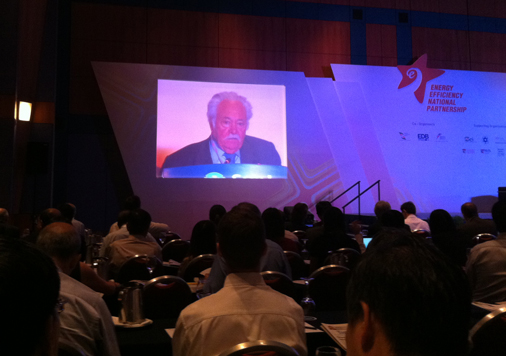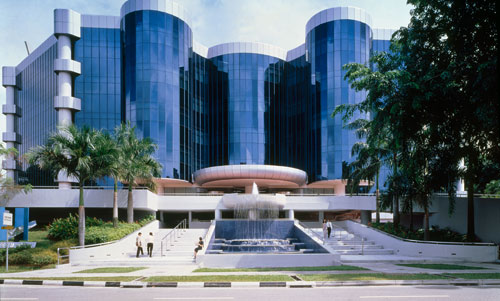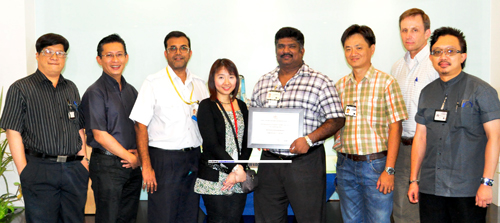
Mr Pasquale Pistorio kicking off the inaugural National Energy Efficiency Conference with his keynote speech. (Photo credit: EMA)
"Can be done" was the rallying call that keynote speaker Pasquale Pistorio made several times at the kick-off to Tuesday's inaugural National Energy Efficiency Conference. With the focus on reducing Singapore's carbon footprint through energy efficiency and renewable sources of energy, Mr Pistorio told audiences that the world's energy needs could, as forecast by WWF,be met almost through renewables by 2050. Of that, only 10 percent would be powered by nuclear energy and fossil fuels, felt the Honorary Chairman and former CEO of ST Microelectronics.
"Can be done" was also echoed by Dr Vivian Balakrishnan at his first event as the new Minister for the Environment and Water Resources. He told the floor that Singapore had been improving its energy efficiency over the past years, and was on course to meeting its 2030 goal of reducing its energy intensity output by 35 percent from 2005 levels.
Dr Balakrishnan also announced an additional carrot of S$22.8 million for the Grant for Energy Efficient Technologies (GREET) scheme, to assist companies buying technology that would help them use energy efficiently. "We will put our money where our mouth is," he said.
The two-day event, organised by the National Environment Agency (NEA), the Energy Market Authority (EMA), and the Economic Development Board (EDB), was capped by the inaugural Energy Efficiency National Partnership (EENP) Awards. Thisrecognised for the first time the efforts of the industrial sector in reducing energy wastage at workplaces, shining the spotlight on six organisationsas well as the Manpower Ministry. Here's what they had to say about the recognition accorded.
Winning strokes
Pfizer Asia Pacific
Industry: Pharmaceutics
Raising the bar for: "Excellence in Energy Management", with the installation of energy monitoring and tracking systems to track and quantify the energy savings of its energy efficiency projects. Also, for "Best Practices" with the installation of a tri-generation plant to improve energy efficiency.
Says Managing Director George Routhier: "The site energy mission is to aggressively pursue innovative and environmentally sustainable methods to reduce energy consumption by at least 5 percent annually. Our plan is to achieve zero usage of electric chiller and zero import of electrical power through continuous energy saving initiatives.We will continue to reduce Pfizer's energy and GHG footprint and prepare the company for the risks and opportunities of climate change in an increasingly carbon constrained world. We will engage our colleagues and our business partners in these efforts."
 Dr Vivian Balakrisnan with Pfizer Asia Pacific's Engineering Services Director Lee Chin Hoo (right). (Photo credit: NEA)
Dr Vivian Balakrisnan with Pfizer Asia Pacific's Engineering Services Director Lee Chin Hoo (right). (Photo credit: NEA)
Glaxo Wellcome Manufacturing
Industry: Pharmaceutics
Raising the bar for: "Excellence in Energy Management", with an annual target to reduce energy usage by 5 percent in absolute terms since 2008, with the help of various EE projects and initiatives put in place by its cross-functional energy management team. Like Pfizer, Glaxo also installed energy monitoring and tracking systems to track and quantify the energy savings of its energy efficiency projects. It also obtained an "Honourable Mention for Best Practices", with its initiative to re-circulate air in hazardous areas in production buildings.
Says Mr Chris Dobson, Vice-President & Site Director, Global & Manufacturing Supply:"GSK is committed to integrating environmental sustainability into our business. We have a responsibility to contribute to meeting environmental challenges, but we also see this as an opportunity. In recent years, energy saving has been a priority for all GlaxoSmithKline and we have now set an annual target to reduce energy usage by 5 percent in absolute terms. I am very please to say that as a result of our Energy Management programme, we have been exceeding that target every year."
 GlaxoSmithKline Singapore's George Lam (right), Director for Operational Excellence & Sustainability, Global Manufacturing & Supply. (Photo credit: NEA)
GlaxoSmithKline Singapore's George Lam (right), Director for Operational Excellence & Sustainability, Global Manufacturing & Supply. (Photo credit: NEA)
Ascendas Lands (S)
Industry: Privately-held commercial real estate developer
Raising the bar for: "Best Practices", with the upgrading of a chiller plant at The Galen.
Says CEO Tan Yew Chin: "Ascendas recognises that while we ensure our new buildings are environment-friendly, we should also focus on making sure that our existing buildings are not neglected. Older buildings generally have lower energy efficiency and present excellent opportunities for us to innovate on our solutions to lower our carbon footprint and, at the same time, optimise the buildings' energy efficiency. The Galen presented us with just such an opportunity. Following the success olf an extensive chiller upgrading project, The Galen now features one of the most efficient chiller plants in Singapore, operating with total efficiency of 0.563 kilowatt per 1 refrigerant tonne of cooling. It enabled the building to save about 5,300MWh of electricity and to reduce carbon dioxide emissions by 2,500 tons per year."
 The Galen. (Photo credit: Ascendas Lands)
The Galen. (Photo credit: Ascendas Lands)

New Tech Park. (Photo credit: CDL)
City Developments Ltd (CDL)
Industry: Singapore-listed real estate developer
Raising the bar for: "Best Practices", with the retrofitting of a chiller plant at the New Tech Park.
Says Mr Anthony Goh, Deputy GM, Property & Facilities Management: "As the building sector accounts for one-third of Singapore's national electricity consumption, CDL is committed to improving our energy performance across our business operations, recognising the global impact of climate change. The installation of energy-efficient equipment in the form of upgrading the chiller plant is in line with... our continued commitment towards corporate social responsibility as Singapore?s leading green developer. CDL has replaced three sets of chiller, cooling tower, chilled water and condenser water pump at New Tech Park. At the same time, the pipe work was reconfigured to ensure minimum frictional losses within the pipeline. This investment in energy-efficient technologies resulted in an improvement in chiller system efficiency from 1.115kW/tonne to 0.586kW/tonne and energy savings of 2,492,087kWh per year and reduction in carbon emissions of about 1,179 tonnes per year."
Eastman Chemicals Singapore
Industry: Subsidiary of New York-listed chemical manufacturer Eastman Chemicals Company
Raising the bar for: "Best Practices", with the energy optimisation of a distillation column.
MSD International GmbH
Industry: Biotechnology subsidiary of international medical supply company MSD International
Raising the bar for: "Best Practices", with its conversion of a motor-driven pump to a steam turbine unit for the chiller water pump.
Says Mr Goh Yong Keng, Engineering Services Leader: "Energy efficiency has been a key focus of the company for the past 15 years and we have been driving and achieving energy savings of more than 5 percent every year. The scale of our Tri-generation facility is currently the biggest within the pharmaceutical industry, helping the company to achieve energy savings of more than 20,000MWh per year. The award-winning steam turbine and absorption chiller conversion project provided an additional savings of more than 2,000MWh of electricity per year, as well as enabled the company to avoid starting an additional mechanical chiller, thus achieving a further cost avoidance of more than S$3 million per year. MSD will continually strive to be a key contributor to energy efficiency in Singapore."
 Dr Vivian Balakhrisnan with MSD's Engineering Services Leader Goh Yong Keng (right). (Photo credit: MSD)
Dr Vivian Balakhrisnan with MSD's Engineering Services Leader Goh Yong Keng (right). (Photo credit: MSD)

The Eagle Services Asia's Pollution Prevention Committee with the award. (Photo credit: ESA)
Eagle Services Asia
Industry: Repair and overhaul of aircraft engines
Raising the bar for: "Honourable Mention for Best Practices", thanks to the optimisation of its heater tanks operation in the cleaning line.
Says Managing Director William Kircher:"At the heart of our energy consumption reduction initiatives is the Pollution Prevent (P2) committee. P2 is a cross functional energy management team which tracks and identifies the large energy consumers in ESA. P2 found our cleaning line operations to be ESA's largest energy consumer and worked out opportunities for energy optimisation. Improvements instituted to reduce the evaporation loss from the heater tanks resulted in 20 percent energy savings, which is equivalent to about S$80,000 savings annually. In addition, we also achieved a 38 percent savings of water loss or S$4,000 annually for the last two years. These results have exceeded our target savings of 10 percent. Looking forward, there are opportunities to further promote energy savings in the cleaning line operations utilising advanced technology such as heat pumps. So far, we have installed thermocouples in each heater tank. Monitoring the temperature through the Building Automation System (BAS) will allow us to collect data online and compile trending to better understand the operational patterns."
Mr Yeo Yee Pang
Industry: Engineering Manager, Glaxo Wellcome Manufacturing
Raising the bar for: "Outstanding Energy Managers of the Year", for an 11-year track record in promoting energy efficiency within and beyond his organisation.
Says Mr Yeo:"Energy saving has been a priority for GlaxoSmithKline's operations in Singapore since 2002. At that time, we were forecasting a 40 percent increase in energy consumption as a result of an increase in manufacturing volume. As a result of our Energy Management programme, we successfully kept our energy usage constant while absorbing that increase in manufacturing volume. Since then, we have implemented almost 300 projects large and small, and saved in excess of S$12.5 million up to the end of 2010."
 Mr Yeo Yee Pang (right), Engineering Manager for GlaxoSmithKline Singapore. (Photo credit: NEA)
Mr Yeo Yee Pang (right), Engineering Manager for GlaxoSmithKline Singapore. (Photo credit: NEA)
Ministry of Manpower (MOM)
Industry: Manpower and the formulation and implementation of related policies in Singapore
Raising the bar for: "Best Public Sector Agency in Energy Management", retrofitting the chiller plant in the MOM Building at Havelock Road to achieve high plant efficiency, as well as other energy-efficient features in the building such as photovoltaic sensors for perimeter lightings and energy regenerative units for lifts.